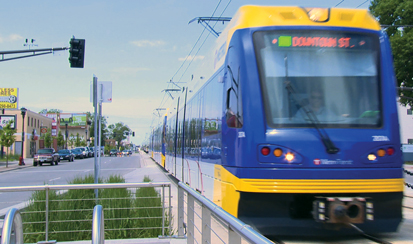Video Supplement: How Can CDFIs Help Small Business Meet Their Challenges?

In 2010, one of Bob Edmond’s top concerns about the major construction set to occur in front of his restaurant was whether the road diversions and elimination of on-street parking would adversely affect access to his business.
“The majority of my customers drive here,” says the co-owner of Big Daddy’s BBQ in St. Paul, Minn., “and I didn’t want them to think that we were closed down.”
Edmond and other entrepreneurs with small businesses situated along the same stretch of University Avenue had good reason to be apprehensive: Much of the street was slated for an 11-mile, $957 million light-rail transit (LRT) line, dubbed the Green Line, that would connect the downtowns of Minneapolis and St. Paul along a strip known as the Central Corridor. The Green Line’s construction would stretch for four years and involve periods of significant pedestrian and vehicular traffic disruption along University, a busy thoroughfare that runs through several distinct commercial nodes. In all likelihood, Edmond and his fellow proprietors could expect a partial—and financially detrimental—interruption in their day-to-day commerce.
To help small and independent businesses along the route weather the construction and position themselves to thrive afterward, more than a dozen nonprofit organizations, foundations, government agencies, and business associations teamed up to form a public-private partnership that has provided a range of proactive and ongoing services to aid the approximately 800 small and independent businesses along the LRT route.1/ The public-private partnership grounded those services in a number of key strategies, described below, that may be useful to other business-support efforts during future large-scale, disruptive construction projects.
Pre-construction: Work together to anticipate businesses’ needs
Well before construction commenced, the Central Corridor public-private partnership took several actions to help business owners have a greater chance of enduring the expected disruptions.
Strategy: Understand the differing roles within the partnership and develop constructive working relationships
For a project the size of the Green Line, in which hundreds of businesses were exposed to long periods of disruptive construction activities, an accounting of which entities were involved in mitigation efforts was a useful first step in identifying the spectrum of services available. Who would disseminate information about construction progress? Who would respond to business owners’ concerns during construction? Charting out the range of services available to business owners and identifying which organizations or government departments would provide them not only prepared the partnership for quicker responses but also clarified where service gaps existed.
“The lines of communication and the relationships that were built before construction started really benefited everyone,” says Isabel Chanslor, a project manager for the University Avenue Business Preparation Collaborative (U7), a group that provided support to small businesses along the St. Paul portion of the Green Line. “The process of getting everyone together and on the same page about the mission was really important.”
Laura Baenen, a communications manager at the Metropolitan Council (Met Council), the regional government body that oversaw the construction, says that surveying businesses to understand their anticipated operational needs was critical for planning purposes. How did businesses get their deliveries? How did garbage trucks access the businesses’ Dumpsters? How did employees and customers reach the businesses’ front doors?
“Once construction got started, it was hard to make really big changes,” she says. “So a lot of the work we had to do happened well before construction got going, during the engineering phase. We had to understand what people needed to operate their businesses, so we could prepare.”
Strategy: Tighten up business operations
Helping businesses improve their day-to-day efficiency better positions them to weather an anticipated slowdown in customer traffic. For up to two years before Green Line construction began, the public-private partnership helped businesses identify ways to strengthen their operations by cutting unnecessary inventory, expanding sales channels, developing customer-oriented communications strategies, sharing costs, or maintaining more accurate books.
U7 also helped some businesses foray into the online realm in order to broaden their exposure, increase sales opportunities, and establish their brands. For instance, with the help of U7 and the Neighborhood Development Center (NDC), a St. Paul-based nonprofit organization, Big Daddy’s BBQ created a web site that helped drive an increase in sales, primarily through catering opportunities advertised online. Bob Edmond attributes the survival of his business during LRT construction largely to the increase in catering.
In addition to establishing a web presence, some businesses created lists of customer e-mail addresses that they used to communicate with core customers during construction and to promote their stores with specials and coupons.
Strategy: Deploy effective outreach staff to serve as navigators
With the Green Line construction looming, outreach staff from the Met Council’s Central Corridor Project Office, along with representatives from other partnership members, served as a bridge to the business community. These personnel acted as information conduits and as navigators for business owners, some of whom found the situation before them confusing and frustrating.
Being able to communicate clearly and effectively was an important facet of this role. For many of the business owners affected by the Green Line construction, English is a second language. The Met Council and other partnership members took this into consideration and deployed outreach staff who spoke the native languages of many of the business owners, which include Hmong, Vietnamese, Spanish, and Somali.
“In many ways, the outreach staff acted as the go-to resource for business owners,” says Shoua Lee, a senior community outreach coordinator for the Met Council. “We handed out magnets with our names and contact information on them and encouraged business owners to contact us if they had a question or concern. If we didn’t know the answer to their question, we would find out that answer and get back to them.”
In addition to promoting one-on-one outreach relationships, the Met Council organized a business advisory committee that met monthly. Business owners would convene to voice some of their concerns during the Green Line's engineering phase and to learn about different facets of the construction.
During construction: Continue mitigation work
Strategy: Expect unforeseen issues
As construction on the Green Line commenced, unforeseen issues inevitably popped up: the need for a negotiable walkway when sidewalks were torn up; construction accouterments, such as storage trailers, obstructing business signage; snow drifts blocking alleys that served as temporary entrances to stores.2/ Outreach staff continued to be an important component of the mitigation plan by providing a means to address these sorts of issues. Sometimes the outreach team members noted and raised the issues themselves; other times it was the business owners who brought them to the attention of the Met Council or of groups such as U7.
“We would get calls from business owners concerned about an access issue, and we would work with them and the other organizations to resolve the problem,” says U7’s Chanslor, noting that she typically knew what recourse to follow because of the early networking and organizing that took place before construction began. “We could often get something moved in a matter of hours.”
Strategy: Spread the word about construction progress and customer access
An important component of the Met Council outreach staff’s business-disruption mitigation plan was the regular dissemination of information regarding the status of construction and access along affected areas. Which sidewalks would be closed? Which driveways would be obstructed? Where could customers park their cars? Where would bus stops be temporarily relocated?
Baenen of the Met Council says that her agency issued weekly updates to keep business owners and the broader public abreast of the construction status. They sent the updates to various media outlets in the Twin Cities, posted them on the Met Council’s web site, and distributed them via an e-mail listserv that contained addresses of people who had attended their outreach meetings and requested the weekly communiqués. The updates—multipage documents with graphics and photos—included maps of the affected areas and were sometimes tailored to a specific business along the active construction zone.
“Those businesses could then e-mail the updates to their customers or put them on their own web sites,” she says. “It was really important for the owners to let people know that there were always ways to access their businesses.”
Another method the Met Council and other partnership members used to communicate access to a store was the strategic placement of signs—in many cases, big, bold, directional signs that customers, regular and potential, could see while passing by in a car or bus.
“We took sign orders from people all the time,” says Chanslor, explaining that U7 outreach staff would meet with business owners and walk their premises to determine the best way to access their buildings. “Even though a lot of the signs were simple arrows, they made a big difference.”
Strategy: Promote businesses through ads, branding, and appearance
Attracting visitors to businesses along the Green Line was another important facet of the mitigation plan. The Met Council hired a marketing firm, Mod & Company, to build a web site spotlighting the commercial districts and individual businesses along the Central Corridor. The site, www.onthegreenline.com, includes a business directory, a list of events, and links to information on construction progress. The Met Council also advertised corridor businesses on Mod & Company-designed billboards, bus side ads, and other places.
Some businesses also reworked their images by creating logos, fine-tuning their brands, or spiffing up their window displays. With the help of government funding, some even made façade improvements.
“Even though a lot of the small mom-and-pop businesses along the LRT route had been around for decades, they had never bothered to really establish a brand,” says Chanslor. “We told them that if they were going to survive and then thrive afterward, establishing an identity was important. If they took that step during the construction phase, then once the light rail line started operating, they’d have the opportunity to expand their customer base.”
Strategy: Provide financial assistance to businesses
Some of the activities associated with the Green Line response plan were paid for with funding from different government agencies and philanthropic entities. Of the nearly $16 million made available to assist businesses during the construction, more than $6 million was allocated to a variety of forgivable loan and grant programs, including programs to help offset revenue losses as a result of business disruption and to increase customer traffic. According to an October 2012 survey of Central Corridor business owners conducted by the Central Corridor Funders Collaborative, a group of philanthropic organizations that are investing in development along the Green Line route, business owners along the corridor ranked financial assistance as one of the most helpful mitigation strategies—particularly small business owners who are foreign-born or people of color.3/
The future will tell
It’s unclear at this point precisely how the mitigation efforts along the Central Corridor have influenced business survival rates. Jonathan Sage-Martinson, the director of the Central Corridor Funders Collaborative, believes the public-private partnership’s work was effective, but indicates that more time needs to pass before making a full evaluation.
“The efforts to mitigate business disruption were largely successful, mainly because they were multifaceted and addressed a number of concerns,” he says. “But I think the real test will be how the businesses are doing one year from now, once the Green Line’s passenger service is fully under way.”
For Bob Edmond of Big Daddy’s BBQ, assistance from entities like NDC and U7 was vital to his restaurant’s continued survival.
“We called on them a lot,” he says. “And they were always there to help.”
The Green Line began operating on June 14, 2014, and additional LRT routes for the Minneapolis-St. Paul area are being discussed or planned. For more information, visit www.metrotransit.org.
Other tactics used to mitigate business disruption
|
1/ Of the approximately 1,400 businesses that fronted the Central Corridor as of 2010, the partnership focused most of its mitigation efforts on the small and independent businesses, defined as those that generate less than $2 million in annual revenue and have fewer than six locations.
2/ The long duration of the construction contributed to the inevitability. According to the Met Council’s Central Corridor Project Office, a typical business would experience disruption for approximately 300 days: 150 days right in front of the business and 150 days across the street.
3/ Mitigating business losses: services, strategies, and effectiveness: A survey of businesses affected by Central Corridor Light Rail construction. Visit www.funderscollaborative.org to access the report.





